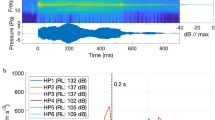Summary
The behaviour and heart rate of nine incubating Adélie penguins (Pygoscelis adeliae) and one chick at crèche age were recorded in a breeding colony at Esperanza Station, Antarctica, during natural activity and disturbance. Heart rates were obtained by safety-pin electrode ECG and implantable radio-transmitters. In adults, minimal heart rate at rest was 86 bpm (beats per minute), rising to a maximum of 127 bpm when the birds were standing. Heart rates reflecting the degree of disturbance rose from resting levels to 110, 118, 127 and 145 when the stimulus was sheathbill, congener, human and helicopter, respectively. In the chick, normal heart rates were higher by 140 bpm than in adults (2.2 kg as opposed to 4.5 kg). Heart rates during natural activity ranged from 220 (sleep) to 287 bpm (food run). Disturbance resulted in heart rate increasing from resting levels to 240 (congener), 260 (approaching helicopter), 273 (helicopter overhead) to 310 bpm (capture by a human). Helicopters even when 1500 m away caused scattering of the birds and other panic reactions. A hand-reared chick in an enclosure did not show any fearful reaction (behaviour, heart rate) to helicopter approach whilst the observer was standing close by which indicates habituation to human disturbance. We propose that wild Adélie penguins, although often seemingly unconcerned, react strongly to man-made stimuli during the breeding season, resulting in reduced fledging and hatching success. Disturbance should be kept to a minimum.
Access this chapter
Tax calculation will be finalised at checkout
Purchases are for personal use only
Preview
Unable to display preview. Download preview PDF.
Similar content being viewed by others
References
Adelung D, Culik B (1988) A method to obtain hand-reared Adélie penguins for physiological experiments. 1st Int Conf on Penguins, Dunedin, New Zealand
Ball NJ, Amlaner CJ Jr (1980) Changing heart rates of Herring gulls when approached by humans. In: Amlaner CJ, Macdonald DW (eds) A handbook on biotelemetry and radio tracking. Pergamon Press, Oxford, pp 589–594
Boyd JC, Sladen WJL (1971) Telemetry studies of the internal body temperatures of Adélie end Emperor penguins at Cape Crozier, Ross Island, Antarctica. Auk 88:366–380
Butler PJ, Woakes AJ (1979) Changes in heart rate and respiratory frequency during natural behaviour in ducks, with particular reference to diving. J Exp Biol 79:283–300
Butler PJ, Woakes AJ (1984) Heart rate and aerobic metabolism in Humboldt penguins Spheniscus humboldtii during voluntary dives. J Exp Biol 108:419–428
Culik B (1987) Fluoride turnover in Ad19élie penguins and other bird species. Polar Biol 7:179–187
Culik B, Adelung D, Heise M, Wilson RP, Coria NR, Spairani H (1989) In situ heart rate and activity of incubating Adélie penguins (Pygoscelis adeliae). Polar Biol 9:365–370
Culik B, Woakes AJ, Adelung D, Wilson RP, Coria NR, Spairani HJ (1990) Energy requirements of Adélie penguin (Pygoscelis adeliae) chicks. J Comp Physiol B (in press)
Davis LS, McCaffrey FT (1986) Survival analysis of eggs and chicks of Ad19élie Penguins (Pygoscelis adeliae). Auk 103:379–388
Duncan DB (1970) Multiple comparison methods for comparing regression coefficients. Biometrics 26:141–143
Duncan IJH, Filshie JH (1980) The use of radio telemetry devices to measure temperature and heart rate in domestic fowl. In: Amlaner CJ, Macdonald DW (eds) A handbook on biotelemetry and radio tracking. Pergamon Press, Oxford, pp 579–588
Heise M (1989) Human-induced tachycardia in wild and tame Mallard (Anas platyrhynchos). Comp Biochem Physiol 92A:125–128
Hughes BO, Black AJ (1976) The influence of handling on egg production, egg shell quality and avoidance behaviour of hens. Br Poult Sci 17:135–144
Jones RB, Duncan IJH, Hughes BO (1981) The assessment of fear in domestic hens exposed to a looming human stimulus. Behav Processes 6:121–134
Jones RB, Faure JM (1981) The effects of regular handling on fear responses in the domestic chick. Behav Processes 6:135–144
Kanwisher JW, Williams TC, Teal JM, Lawson KO (1978) Radiotelemetry of heart rates from free ranging gulls. Auk 95:288–293
Lishman GS (1985) the comparative breeding biology of Adelie and Chinstrap penguins Pygoscelis adeliae and P. antarctica at Signy Island, South Orkney Islands. Ibis 127:84–99
Perry G (1973) Can the physiologist measure stress? New Sci 60:175–177
Sladen WJL, Leresche RE (1970) New and developing techniques in Antarctic ornithology. In: Holdgate WM (ed) Antarctic ecology, vol 1. Academic Press, London, pp 585–596
Spurr EB (1975) Behaviour of the Adélie penguin chick. Condor 77:272–280
Stout JF, Schwab ER (1980) Telemetry of heart rate as a measure of the effectiveness of dispersal inducing stimuli in seagulls. In: Amlaner CJ, Macdonald DW (eds) A handbook on biotelemetry and radio tracking. Pergamon Press, Oxford, pp 603–610
Thompson RB (1977) Effects of human disturbance on an Adélie penguin rookery and measures of control. In: Llano GA (ed) Adaptations within Antarctic ecosystems. Smithsonian Inst. Washington, DC, pp 1177–1180
Volkman NJ, Trivelpiece W (1984) Growth in pygoscelid penguin chicks. J Zool Lond 191:521–530
Wilson GJ, Taylor RH, Barton KJ (1988) Long-term impact of humans on Adélie penguins at Cape Halett. 5th SCAR Symposium on Antarctic Biology, Hobart, Australia
Wilson RP, Culik B, Adelung D, Coria R, Spairani H (1990) To slide or stride; when do Adélie penguins toboggan? Can J Zoo (in press)
Woakes AJ, Butler PJ (1986) Respiratory, circulatory and metabolic adjustments during swimming in the diving duck Aythia fuligula. J Exp Biol 120:215–231
Author information
Authors and Affiliations
Editor information
Editors and Affiliations
Rights and permissions
Copyright information
© 1990 Springer-Verlag Berlin Heidelberg
About this paper
Cite this paper
Culik, B., Adelung, D., Woakes, A.J. (1990). The Effect of Disturbance on the Heart Rate and Behaviour of Adélie Penguins (Pygoscelis adeliae) During the Breeding Season. In: Kerry, K.R., Hempel, G. (eds) Antarctic Ecosystems. Springer, Berlin, Heidelberg. https://doi.org/10.1007/978-3-642-84074-6_18
Download citation
DOI: https://doi.org/10.1007/978-3-642-84074-6_18
Publisher Name: Springer, Berlin, Heidelberg
Print ISBN: 978-3-642-84076-0
Online ISBN: 978-3-642-84074-6
eBook Packages: Springer Book Archive




